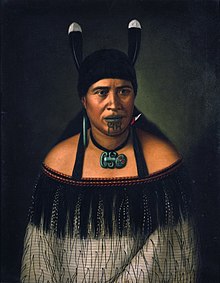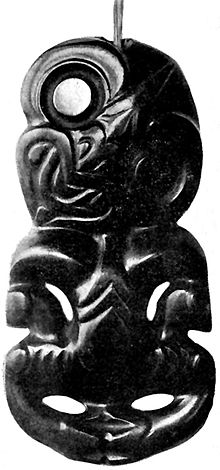Hei-tiki
A Hei-Tiki (also Hei-tiki ) is an ornament of the Māori of New Zealand that is worn around the neck.
materials
Hei-tiki are usually made from pounamu (greenstone) and worn around the neck. They are often mistakenly referred to as tiki . Tiki are actually large human figures, carved from wood, or smaller wood carvings that mark sacred places.
The most valuable Hei-Tiki are made from greenstone (or pounamu ). New Zealand greenstone is made from either nephrite (a form of jade ) or bowenite (called tangiwai ). Pounami is highly respected by the Māori because of its beauty, robustness and hardness; it is not only used for jewelry, but also for carving tools or weapons. In the Māori language, the different types of greenstone are called kahurangi (bright green), inanga (whitish), kawakawa (slightly transparent) and tangiwai (bowenite).
Types of a Hei-Tiki
There are two main types of Hei-Tiki. One type has been common for a long time and is seen in a third of Hei-Tiki. The head-to-body ratio is 30/70, they are rich in details such as ears, elbows or knees. The head is inclined, one hand is on the hip, the other on the chest. The eyes are not as big as the second species, which is generally heavy, has a head-to-body ratio of 40/60. Both hands are on the hips.
popularity
In addition to other taonga (precious possessions) that are worn for adornment, bone carvings in the form of earrings or necklaces are common. For many Māori, wearing this jewelry is an expression of their cultural identity. Such jewelry is becoming increasingly popular with New Zealanders of all origins as a symbol of New Zealand's identity in general. Jewelry of this kind is now exported. A fish hook ( Hei Matau ), carved out of bones, is particularly popular . Some actors have worn such jewelry, such as Viggo Mortensen in the film adaptation of The Lord of the Rings . This may have contributed to global interest in Māori culture and art.
literature
- TR Hiroa (Sir Peter Buck): The Coming of the Maori. 2nd Edition. Whitcombe and Tombs, Wellington 1974. (first edition 1949)
Web links
- www.maori.info Further information about Hei-Tiki, illustrated (English)

